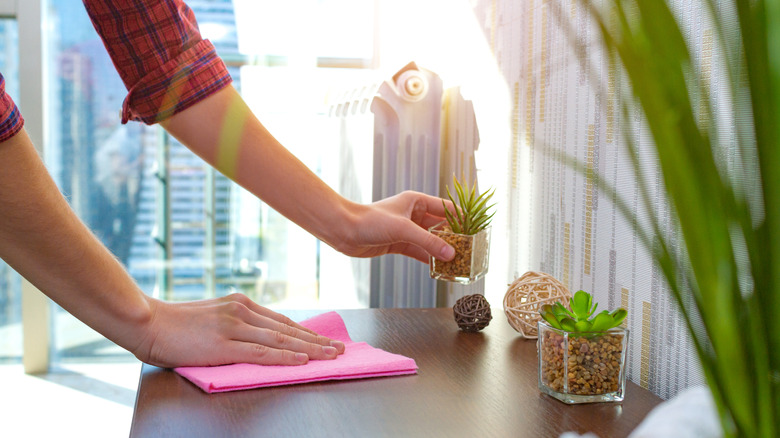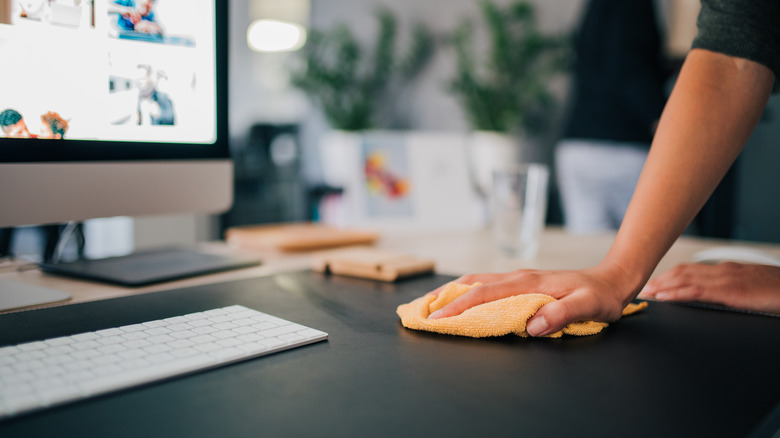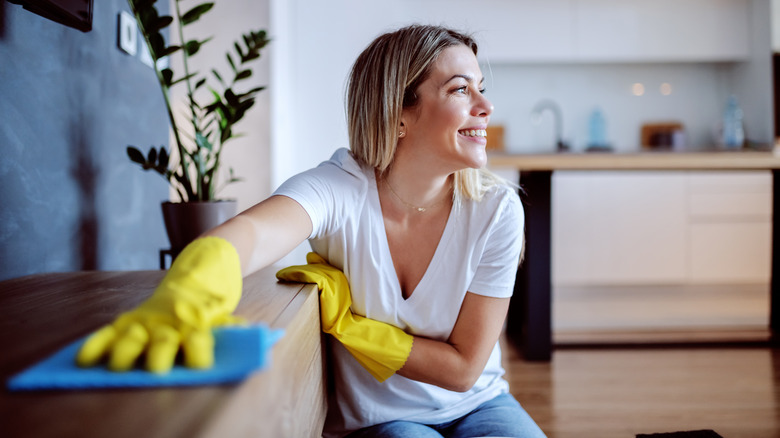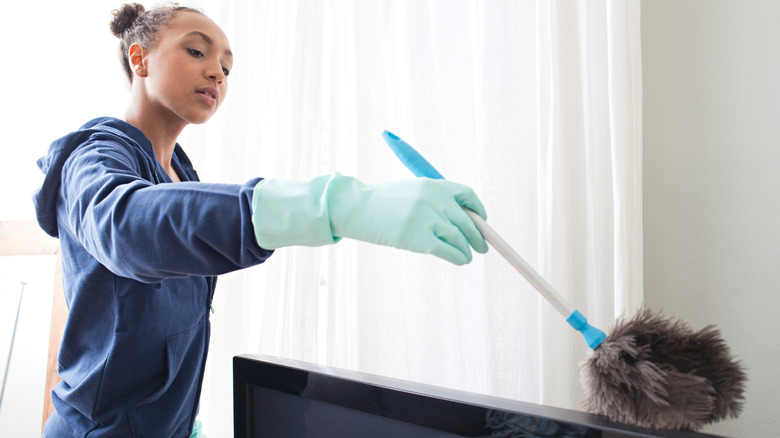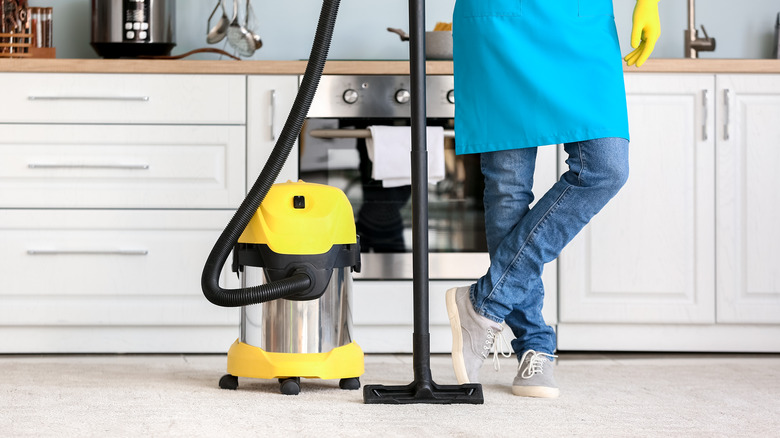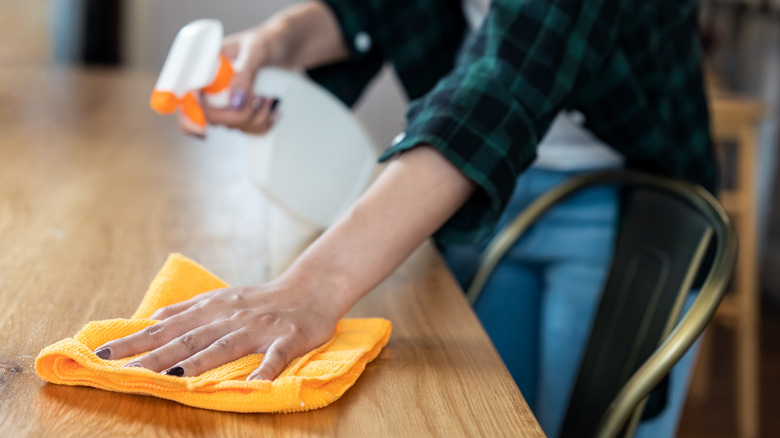Dusting Mistakes You've Been Making This Whole Time
Everyone has their own cleaning routine when it comes to dusting their home, but it's pretty easy to wonder whether or not you're making any dusting mistakes. And when it comes to dusting, you most likely want to be as quick and efficient as possible. Cleaning is a labor-intensive task that keeps us away form doing more enjoyable tasks, like meeting up with friends for an aperitif or snuggling up on the couch for a Netflix binge-watching session. But even though not many people look forward to dusting day, dusting is an important chore that will keep your house sanitized and dust mite-free. But just like with any other task, there is an efficient way to dust, and there is a sloppy way to dust.
Dusting efficiently ensures that you get the majority of dust off of your rooms' surfaces and guarantees you won't see a thin layer of dust on shelves and tables a day or two later. If you feel like your room is dusty hours after you cleaned it, then you might need to tweak your routine. We here at House Digest have gathered some of the most common dusting mistakes everyone is guilty of, and we even included tips on how to fix them. (You can thank us later.) These small tweaks will make your cleaning day much more productive.
You dust with a dry rag
Most people use a cleaning spray or a homemade solution when dusting, since that is the most efficient way to trap dirt on a rag. But there are moments when you see a spot of dust that you missed on the table or TV console, and you grab a dry rag to wipe it away. While that might not necessarily be bad for spot treatments every now and then, you want to avoid dry dusting entire surfaces. According to Abe Navas, a general manager of Emily's Maids, dry dusting doesn't actually wipe away the dirt. Instead, it basically moves it all over the place. "Dust is just an accumulation of tiny particles on a surface, so any little disturbance will send them flying into the air," Navas told Apartment Therapy. "Your rag doesn't trap the dust; it just moves it around." You have to use a damp rag if you want to wipe away the dust permanently.
You don't dust top to bottom
While dusting might seem like a chore that doesn't need a tutorial, there is in fact a method to it. In order to ensure that you're not dirtying surfaces you have already cleaned, you want to dust from the top to the bottom. That means that you need to first dust things closest to your ceiling, like ceiling fans, light fixtures, and crown moldings, and then work your way down to the floor.
If you do dusting process in the reverse, then the dust on your light fixtures could float down to the tables and shelves you have already polished. In addition, dusting from the bottom up will create a bigger mess, because you are moving through dust that accumulated in the room and spreading it across more surfaces. "If you start cleaning on the ground, you'll stir up dust rather than get rid of it," Tori Toth, a New York City home stager, told Martha Stewart.
You are using the wrong tools
More and more people are trying to eliminate the use of paper towels when cleaning in an effort to become more eco-friendly, and as an alternative, they have created their own cleaning rags out of old bedsheets, t-shirts, and towels. While DIY rags are a greener alternative to one-time-use paper towels, they might not be the most effective tool for cleaning. If you want to clean quickly but efficiently, consider investing in a pack of microfiber towels instead. "Microfiber, thanks to its microscopically tiny weave, holds 10 times more dirt per square inch than its cotton counterparts, so you will collect more dust and keep it from redepositing as you clean the next surface," Melissa Homer, the chief cleaning officer at MaidPro told The Strategist. You also want to avoid feather dusters for that same reason. They tend to move dust around rather than actually cleaning it up.
You don't clean your dusting tools
Cleaning is a never-ending process. Not only is it important to clean furniture and surfaces so they are dust-free, but it's important to clean the tools you clean with! If you don't wash your rags or clean your vacuum, then you're not cleaning effectively, because grimy tools will only further dirty your surfaces. A case in point: A 2013 study published in the Applied and Environmental Microbiology journal found that vacuums will kick back mold and bacteria into the air through their emissions if they are not cleaned properly.
"Our results show that although vacuum operation is typically brief, vacuum emissions can release appreciable quantities of human-derived bacteria," the study explained. This can cause allergies and potential illnesses, so you want to make sure that you're cleaning out your vacuum on a regular basis. A simple canister scrub-down can sanitize your vacuum, and it will ensure that you're not multiplying the germs and dust that you were originally hoping to clean.
You spray wood polish right on your wood
If you have ever tried to clean your wooden furniture with all-purpose cleaner, then you probably know firsthand that your mahogany or oak pieces can end up looking dingy over time. Wood polish helps to protect and buff your wooden furniture, but there is a special way to apply it — and it doesn't involve directly spraying the solution onto your furniture. Instead, you want to spray the solution onto your rag, and then apply it to the furniture. Jennifer Rodriguez, chief hygiene officer at Pro Housekeepers told Best Life that doing the opposite "causes one area to get soaked in polish," which can result in a permanent stain over time. Save yourself the stress and heartache, and spritz your cleaner onto your microfiber rag instead. Buff the solution into your piece of furniture using the soft microfiber towel, and then use a second dry cloth to wipe away any excess moisture. (Wood will warp and stain if it sits in any kind of moisture.)
